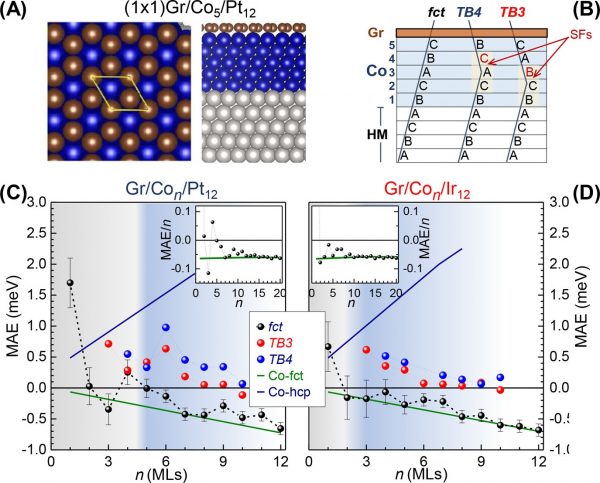Large perpendicular magnetic anisotropy in nanometer-thick epitaxial graphene/Co/heavy metal heterostructures for spin–orbitronics devices
A combination of theoretical modeling and experiments reveals the origin of perpendicular magnetic anisotropy (PMA) in graphene/Co/heavy metal (Pt and Ir) multilayer heterostructures and explains its behavior as a function of the Co thickness. The large experimental critical thicknesses sustaining PMA can only be retrieved in the authors calculations by the inclusion of stacking defects. They find that these defects promote a local hcp stacking, such as twin boundaries or stacking faults that, indeed, are observed in high resolution STEM images.
Understanding the ultimate reasons why Perpendicular Magnetic Anisotropy (PMA) prevails in real multilayer heterostructures is of utmost importance for advancing in the design and development of fabrication processes of spintronic and spinorbitronic devices, e.g., race track memories based on magnetic domain walls or skyrmion motion. In this context, it is instrumental to bridge the gap between the nano- and micro-scales, typically found between state-of-the-art first-principles calculations for ideal systems and the real size of the grown multilayer heterostructures, respectively. This represents a tremendous challenge, because it is precisely in the transition region between these two scales where a delicate balance between quantum-sized effects and the appearance of structural defects determines the properties of the real system.
In this work, the researchers have used a recently developed technique to grow heavy metal/cobalt/graphene multilayer heterostructures. There, the cobalt (Co) planes follow a fct-stacking (fct stands for fcc with lateral tensile strain) and show a reduced number of defects. The evolution of the magnetic properties with Co thickness has been characterized by state-of-the-art techniques, such as Magneto Optic Kerr Effect (MOKE) and X-ray Magnetic Circular Dichroism (XMCD). Both on Pt(111) and Ir(111), these multilayered heterostructures show PMA at unexpectedly large Co thickness; above 20 Co monolayers in the case of Pt(111) buffer layers. Remarkably, we have also unraveled the origin of this observation identifying stacking defects, actually observed in our high-resolution electron microscopy images as the main factor sustaining the PMA at such unusually large thicknesses.
In brief, and although it looks counterintuitive at first glance, the authors found that the presence of locally hcp stacked Co layers, due to stacking faults or twin boundaries, incorporates a further interface in the Co film, which leads to a remarkably large contribution to the PMA. Additionally, thanks to the performed first-principles calculations they were able to quantify the interfacial contributions to the orbital moment anisotropies, finding a surprisingly large value for the Co/graphene interface.

Figure: Calculated magnetocrystalline anisotropy energy (MAE) for (1 × 1)-Gr/Con/HM12 heterostructures. (A) Representative top and side views of the model used for the ideal fct structure with HM = Pt and n = 5 MLs. (B) Scheme of the different layer sequences used, without stacking faults (ideal fct) and with one twin boundary starting at the third (TB3) or fourth (TB4) layer of the Co film. (C) and (D) MAE as a function of the Co thickness n calculated for the stacking sequences indicated in panel B, in the case of HM= Pt and Ir, respectively. Symbols correspond to (1 × 1)-Gr/Con/HM12 heterostructures with different stacking sequences (black, red, and blue are used for ideal fct, TB3 and TB4, respectively), whereas continuous lines refer to bulk Co phases (fct and strained hcp indicated in dark blue and green, respectively). Shadowed areas emphasize the predicted PMA Co critical thickness, nC, for ideal fct films. Insets show the MAEs normalized by the Co thickness, n, for the ideal fct films with n up to 20 MLs, in order to illustrate their convergence toward the bulk Co-fct values indicated by the horizontal green line.
Our dear friend and colleague Jorge Iribas Cerdá was the driving force of this project but he suddenly passed away too early on June 16, 2021. Therefore, this work represents part of his legacy to the scientific community and we would like to dedicate it to his memory.



